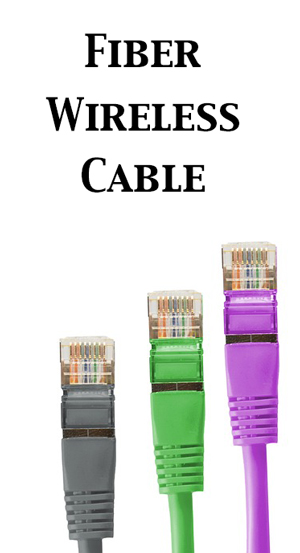You’re stretched for bandwidth. Perhaps the telco is telling you that they won’t renew your T1 or ISDN lines, as they are dropping their support for copper telecom services. You know the solution to either of these dilemmas is an upgrade to fiber optic bandwidth. Once it is installed, you can get all the bandwidth you need now and upgrade easily in the future. One problem. There are no fiber buildouts near you.
That leaves you with two unpleasant possibilities. Either pay a small fortune in construction costs to have fiber pulled-in, or forget fiber because there is none to be had for your location. Not so fast. There is another possibility. Get fiber performance without the actual fiber.
 What Acts Like Fiber But Isn’t Fiber?
What Acts Like Fiber But Isn’t Fiber?It isn’t those little glass strands that are so valuable to your business. It’s the bandwidth they carry. Your network doesn’t need to know or care how the traffic is carried in the metropolitan or wide area networks. There just needs to be enough bandwidth with low enough latency, jitter and packet loss. Anything that does that is virtually fiber.
Let’s take a look at two good options for high speed business Internet connectivity that can give you fiber optic performance but without the issue of having to install fiber where there isn’t any.
No fiber, No Wires At All
The first possibility is Fixed Wireless Access or FWA. Back in the day, this was known as microwave relay. Telephone companies put up massive towers with equally massive horn antennas to beam microwave signals from point to point. The traffic was bundles of telephone calls or television transmissions.
Today there are thousands of towers dotting the landscape in town and throughout rural areas. These were erected to support cell phone service. After several generations of technical advancement, we arrive at the newest standard: 5G or fifth generation. The 5G system uses a variety of bands in the megahertz and gigahertz range. The highest frequency or shortest wavelength equipment runs well into the microwave part of the spectrum and has massive bandwidth capability.
The higher the population density, the more 5G capability you’ll find. For smaller businesses, a fixed location cellular modem that plugs into your network can give you the reliable connection you need with lots of bandwidth available at reasonable prices. In other areas 4G LTE is a reasonable alternative and a very mature technology. If you need dozens of Mbps rather than hundreds or thousands, a 4G LTE modem with specially designed antennas for better signal capture can get the job done.
Not all fixed wireless is dedicated to the cellular phone industry. Some use licensed and unlicensed bands to deliver wireless Internet access over a limited area. You may have a small dish or other antenna installed on your building and aimed at the provider’s antenna. That gives you a strong signal regardless of weather conditions. Some private FWA providers can offer gigabit and higher bandwidths that feature low latency, jitter and packet loss just like fiber. Very high usage or even unlimited usage plans are available. Unlike new fiber installations, you can get service up and running in days rather than months or longer. Installation fees range from nothing to a reasonable one time fee.
It’s a Cable, But No Fiber Inside
The second good option to fiber optic service is cable broadband. Yes, this is the most recent incarnation of the Cable TV revolution. What’s new is that cable has gone far beyond its community antenna roots. Most of cable's infrastructure is now fiber. Surprised? Fiber is the only way these companies can transport all those TV channels and all the data.
So, if the cable companies use fiber why not just get them to connect you to their fiber network. They will, if you are close enough to a fiber access point and the construction issues aren’t too great. Otherwise, they’ll simply run the last few hundred feet or so with the familiar coaxial copper cable.
Can cable service on that coax really replace fiber? In a lot of cases, yes. The reason is that the cable modem standards have been massively upgraded over the years. Today’s DOCSIS 3.0, 3.1 and 4.0 modems deliver hundreds of Mbps up to 10 Gbps. That’s right. You can get some of the highest fiber optic speeds delivered via a DOCSIS 4.0 modem connected to a coax cable.
Will Non-Fiber Work For You?
In many, many cases, Fixed Wireless Access and cable broadband can make good substitutes for Ethernet over Fiber optic bandwidth. There are a couple of caveats, however. Wireless bandwidth isn’t as unlimited as what you can put through one or more fiber strands. As such, you may find that there are limits to your speed or usage, depending on what services are available for your location. Cable broadband is an inherently shared service, meaning that bandwidth may vary somewhat depending on how many users are on the cable and how much bandwidth they are using at any given time.
Even so, many businesses don’t need or need to pay for dedicated bandwidth of 1 to 100 Gbps. You may find that wireless and cable offer tremendous cost savings and can deliver all the performance you really need. Why not check out the range of bandwidth options available for your business now?

